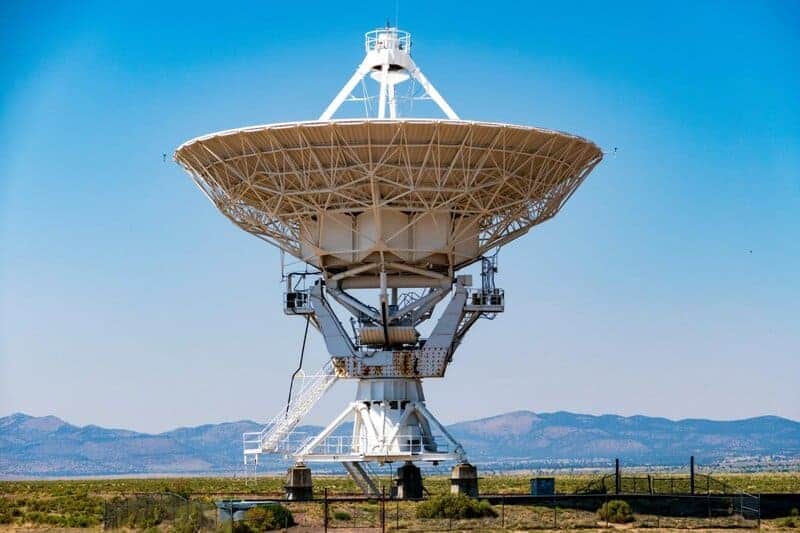For centuries, people have gazed at the night sky, wondering if we are truly alone in the universe. Despite the billions of stars and potentially habitable planets identified by astronomers, our search for extraterrestrial intelligence has resulted in a resounding silence. From the pioneering efforts of SETI to the latest missions like NASA’s TESS, humanity’s fascination with alien life remains undiminished. Yet, the absence of contact persists, posing one of science’s most profound mysteries and fueling ongoing debates about our place in the cosmos.
1. The Fermi Paradox: A Cosmic Puzzle
 Enrico Fermi stands by a blackboard, chalk in hand, pondering the famous question: “Where are the aliens?” | Photo by Openverse
Enrico Fermi stands by a blackboard, chalk in hand, pondering the famous question: “Where are the aliens?” | Photo by Openverse
In 1950, physicist Enrico Fermi famously asked, “Where is everybody?”—a question that became known as the Fermi Paradox. Given the vast number of stars and potentially habitable planets in our galaxy, the odds suggest that intelligent life should be widespread and detectable. Yet, despite decades of searching, we have found no definitive evidence. This paradox challenges our assumptions about life in the universe and compels scientists to rethink why, in a seemingly crowded cosmos, we remain alone and unheard from other civilizations.
2. The Scale of the Universe

The sheer immensity of our galaxy is staggering: the Milky Way contains an estimated 100 to 400 billion stars, many with their own planetary systems. Astronomers have identified thousands of exoplanets, with a significant portion located in the so-called “habitable zone” where life could potentially thrive. Statistically, it seems almost inevitable that life exists elsewhere. As noted by NASA, these numbers make the silence of the universe even more perplexing and drive our quest for answers.
3. SETI and the Search for Signals

For over sixty years, the Search for Extraterrestrial Intelligence (SETI) has scanned the skies for artificial radio signals from distant civilizations.
Using powerful radio telescopes and advanced algorithms, SETI researchers have sifted through mountains of cosmic noise in hopes of finding a message from beyond Earth.
Despite these sustained efforts, no confirmed alien signals have been detected.
This ongoing silence challenges our expectations and pushes scientists to refine their methods and explore new possibilities (SETI@home).
4. Introducing the Contact Era Theory

In 2022, a new idea called the Contact Era theory emerged, offering a fresh perspective on the search for extraterrestrial life. This theory suggests that meaningful contact between civilizations is unlikely until both parties have reached a specific technological threshold—particularly after developing radio communications. As outlined in research published by Live Science, the theory proposes that civilizations may only become aware of each other during a brief “window” when technology allows for interstellar messaging, potentially explaining the ongoing silence.
5. The Age Threshold for Alien Contact

The Contact Era theory emphasizes that the likelihood of interstellar contact increases significantly as civilizations mature technologically. Research indicates that once a society has developed radio communications, it may take hundreds or even thousands of years before effective contact becomes feasible. As detailed in a Scientific American article, older civilizations have more time to broadcast, explore, or even travel between stars, dramatically raising the chances of making contact with others who have reached a similar level of advancement.
6. The Great Filter Hypothesis

The Great Filter hypothesis offers another explanation for our cosmic solitude.
It suggests that there is a critical barrier, or “filter,” that prevents life from advancing to the stage of interstellar communication or travel.
This filter could be behind us—meaning intelligent life is exceedingly rare—or still ahead, posing a fatal hurdle for advanced civilizations.
As explained by BBC Future, the Great Filter concept raises profound questions about humanity’s future and the true odds of alien contact.
7. Past vs. Future Barriers

Debate continues over whether the Great Filter is in our past or future. If it lies behind us, perhaps the emergence of life or intelligence is incredibly improbable, making Earth unique. If the filter lies ahead, the real threat could be the survival of advanced civilizations—such as extinction events, environmental collapse, or technological self-destruction. As discussed in NPR, this uncertainty shapes how we interpret the silence and the prospects for our own species.
8. Quiet, Loud, and Grabby Aliens

Recent ideas categorize alien civilizations as ‘quiet,’ ‘loud,’ or ‘grabby.’
‘Loud’ aliens would rapidly expand through the galaxy, making their presence obvious through megastructures or powerful signals.
‘Quiet’ aliens, in contrast, might remain hidden, self-destruct, or lose interest in interstellar communication.
The ‘grabby’ universe hypothesis suggests that ambitious civilizations could transform vast regions of space, leaving unmistakable signatures.
A detailed exploration can be found at Scientific American, raising intriguing questions about which type might prevail—and why we have yet to detect any at all.
9. Why Loud Aliens May Not Exist Nearby

If ‘loud’ civilizations—those that expand aggressively or broadcast powerful signals—were common in our corner of the galaxy, we would almost certainly have noticed their presence by now.
The absence of observable megastructures or unmistakable signals implies that such civilizations are either extremely rare or simply do not exist nearby.
This supports the idea that our neighbors, if they exist, may be either quiet or entirely absent.
For more, see Space.com.
10. Advanced Communication: Going Dark

As civilizations advance, they may abandon noisy broadcast signals in favor of more efficient, secure communication methods. Technologies such as fiber optics, laser transmissions, or encrypted digital messaging minimize energy loss and reduce the risk of unwanted detection. This evolutionary leap could make advanced societies virtually invisible to our current search strategies. As explained by SETI Institute, this “going dark” phenomenon may be a key reason why we have yet to intercept alien transmissions, even if intelligent life exists.
11. The Shift in Human Technology

Our own technological evolution offers important clues. Earth’s communications have rapidly shifted from analog radio waves to highly efficient digital and laser-based systems. Much of our modern data now travels through fiber-optic cables, making terrestrial signals increasingly faint and harder to detect from space. This same trend could apply to alien civilizations, whose signals might only be briefly detectable before “going dark.” For more, see NASA.
12. Rethinking Alien Technosignatures

As traditional radio searches yield no results, scientists are broadening the hunt for alien life by seeking technosignatures—indirect signs of advanced technology.
These could include waste heat from massive energy use, unusual atmospheric chemicals, or even artificial light on distant planets.
By looking for these subtle traces, researchers hope to detect civilizations that may not be broadcasting radio signals at all.
For more about ongoing efforts, visit NASA Astrobiology.
13. The Role of Artificial Intelligence

Some experts speculate that advanced civilizations may rapidly develop artificial intelligence that fundamentally alters their trajectory. AI could either outlive and replace its creators or decide to halt interstellar expansion for reasons humans cannot predict. This scenario would dramatically shorten the time window during which such civilizations are detectable from afar. For a deeper look into this possibility, see Brookings Institution.
14. The Brief Lifetime of Civilizations

Recent studies indicate that the period during which civilizations are detectable by their technological signals may be remarkably short—sometimes just a few hundred years.
Societies might quickly transition to undetectable technologies, self-destruct, or simply lose interest in interstellar outreach.
This fleeting window could explain why we have yet to intercept alien transmissions.
For more on the limits of civilization lifespans and detectability, see Nature.
15. SETI’s Modern Approach

To keep pace with evolving theories, SETI is now expanding its search beyond traditional radio waves. Researchers are hunting for technosignatures across the electromagnetic spectrum, including infrared, optical, and even laser emissions. New platforms and instruments, like the Allen Telescope Array and space-based observatories, are increasing the odds of detecting subtle signs of alien technology. For more on this adaptive strategy, visit SETI Institute: Technosignatures.
16. The Communication Lifetime Challenge

A major hurdle in interstellar contact is the brief overlap of detectable communication windows.
For two civilizations to notice each other, both must maintain active, detectable signals for thousands of years—an extraordinary feat.
Given the vastness of time and space, the odds of these windows overlapping are slim.
As highlighted by Space.com, this timing challenge may be one of the main reasons we have yet to connect with alien intelligence.
17. Multiple Factors at Play

Scientists increasingly believe that no single answer explains our cosmic silence. The solution likely involves a combination of factors: perhaps life is genuinely rare, interstellar travel is far more challenging than imagined, and technological civilizations are short-lived or go undetectable quickly. As discussed in Scientific American, this complex interplay of barriers makes the mystery of alien contact even more nuanced and difficult to unravel.
18. The Impact of Human Bias

Our search for extraterrestrial intelligence is inevitably shaped by human assumptions and biases.
We often imagine aliens will use technologies or communication methods similar to our own, potentially overlooking unfamiliar or advanced forms of signaling.
As noted by NASA, our expectations may limit both where and how we look for alien life, highlighting the need for open-mindedness and innovation in the search for cosmic company.
19. The ‘Zoo Hypothesis’ and Non-Interference

One intriguing theory, known as the Zoo Hypothesis, proposes that advanced extraterrestrial civilizations may be deliberately avoiding contact with us.
Much like zookeepers observing animals, they could be watching humanity from afar, choosing not to interfere with our natural development.
This idea suggests that silence doesn’t mean absence, but rather a conscious choice to remain hidden.
For a deeper exploration of this concept, see Encyclopaedia Britannica.
20. The Ongoing Cosmic Silence

Despite our best efforts and the enormity of the cosmos, the universe remains profoundly silent. This quiet stirs both wonder and existential contemplation—are we truly alone, or simply not yet ready for contact? The philosophical implications are immense, shaping how we view ourselves and our place in the cosmos. For an exploration of the emotional and intellectual impact of this silence, see National Geographic.
21. The Promise of the Contact Era

The Contact Era theory offers a refreshing sense of optimism for humanity’s search for cosmic company.
Rather than being centuries too late, it suggests we may be approaching the very threshold when interstellar contact becomes likely.
With each technological leap and expanding search strategy, we move closer to that pivotal window.
As highlighted in Live Science, the silence may not signify emptiness, but the calm before a groundbreaking conversation—one that could finally answer the age-old question: Are we alone?
Conclusion

The question of whether we are truly alone in the universe remains one of humanity’s greatest and most profound mysteries. The Contact Era theory breathes new hope into this age-old quest, suggesting that our moment of cosmic connection could be just ahead, not lost to history. As our technology and search methods evolve, so does our capacity to detect even the most subtle signs of intelligent life. Let us remain curious, vigilant, and open-minded—for the universe’s silence may yet give way to extraordinary discovery.



Vielleicht interessiert es Sie:
Wussten Sie! Minensuchratten auf dem Schlachtfeld und sie sind super effektiv!
Wie viele Giraffenarten gibt es? Leben sie alle in Afrika?
Der Vogel ist das Weibchen der Vögel: wahr oder falsch?
Warum bauen Biber Dämme? Welchen Nutzen?
Warum leben manche Tiere nachtaktiv? Welche Vorteile?
Küssen Tiere? Ist das die gleiche Bedeutung wie Menschen?
200+ Hilarious Seahorse Jokes That Will Make You Smile and Giggle
200+ Funny Investment Jokes to Boost Your Financial Humor Game